As you'll have read last week, we were in Vienna all week teaching. This was Kimberly's first visit to the city (and country), I was in Vienna for a couple of weeks back in the late 1990s. We both had a lot of work to do over the weekend before heading to Barcelona for TechEd EMEA (where I'm posting this from), but on Sunday we took some time off to do some sight-seeing. The main event of the day was seeing a performance of the Lippizan stallions at the world-famous Spanish Riding School. We splurged on front-row seats which were well worth it to be right-up close as they performed. The level of control and skill of both riders and horses was amazing!
On Monday I didn't have as much work to do as Kimberly so I left her working in the hotel and went out wandering through the city to indulge my passion for historic architecture, and ecclesiastical architecture in particular. I'm not religious at all but I love the feeling of age and antiquity you get from really old churches – and Europe is filled with ancient churches, especially Vienna. So in the space of one afternoon I managed to tour around 11 churches in central Vienna, plus the Imperial Crypt. Below I've included some photos from my wanderings, with some notes about each of the churches I visited. Click the images for larger (1024×768) versions. Enjoy!
(Ok – this turned out to be a lot longer than I first thought, but was fun to put together – Wikipedia is excellent!)
Dominikanerkirche (Dominican Church)
This church was founded by Dominican monks in 1237, and enlarged extensively through the rest of the 1200s. The present church was built in the 1630s by Antonio Canevale, including ceiling frescoes by Carpoforo Tencalla and Rauchmiller.
The images below show: the High Altar; the pipe organ; the ceiling frescoes and amazing ceiling detail.
Jesuitenkirche (Jesuit Church)
The Jesuits moved their headquarters here in 1620s and the church was redesigned by Andrea Pozzo from 1703-5. One of the most striking features are the spiral marble columns on either side of the side-chapels. The ceiling frescoes, again by Pozzo, use a clever trompe l'oeil effect (painting images that make a two-dimensional surface look three-dimensional). In this church I was able to go into the crypt, which is still in use for burials.
The images below show: the ceiling dome with the trompe l'oeil effect; the High Altar; the spiral marble columns; down in the catacombs.
Franziskanerkirche (Church of St. Jerome)
This church was founded by Franciscan monks in 1603 on the site of a medieval convent. The interior is full-blown Baroque style. The High Altar, again by Andrea Pozzo, uses the trompe l'oeil effect – only the front of the structure is three-dimensional. The church contains the oldest pipe organ in Vienna, designed by Johann Wockerl in 1642.
The images below show: the vaulted ceiling; the High Altar centerpiece; the pipe organ.
Annakirche (Church of St. Anne)
There has been a chapel on this site since 1320, although the present church dates from 1629-1634 and was renovated by the Jesuits in the early 1700s. The ceiling frescoes are by Daniel Gran, as is the painting of St. Anne at the top of the High Altar.
The images below show: the High Altar; the ceiling frescoes.
Malteserkirche (Church of Saint John of the Täufers)
This church was founded in the early 1200s by the Knights of Malta who were invited to the city by Duke Leopold VI. The current church is from mid-1400s, and was rebuilt in 1800s in the Baroque style, although much of the Gothic interior was retained.
The image below shows the simple interior, common to the older Gothic style, with the High Altar.
Kapuzinerkirche (Church of St. Mary of the Angels)
This church is one of the youngest I visited, founded in 1617 by Capuchin friars, who traditionally look after the Kaisergruft under the church.
The image below shows the church interior looking at the High Altar.
Kaisergruft (Imperial Crypt)
The Imperial Crypt was founded in 1619 by Emperor Matthias as the resting place for the remains of the Hapsburg family (the hereditary Holy Roman Emperors). The remains of 138 Hapsburgs are here, including Emperors, Empresses, Archdukes, Archduchesses, and many members of their families. The most recent burial here was in 2008.
The images below show: an example sarcophagus; a Death's head adornment on the sarcophagus with an Imperial crown.
Augustinerkirche (St. Augustine's Church)
This church was built in the 1300s and has the best preserved Gothic church interiors in Vienna. One of the highlights is the tomb of Archduchess Maria Christina, created by Italian Neoclassical sculptor Antonio Canova after her death in 1798. The tomb is of course empty as the remains are in the Kaisergruft.
The images below show: looking through the Nave to the High Altar, with the fabulous Gothic interior; Maria Christina's tomb.
Michaelerkirche (Church of St. Michael)
The earliest parts of this church date from the 1200s, and the choir dates from 1327-40. The Neoclassical façade was added in 1792 by Ernest Koch, with the porch topped by Baroque statues by Lorenzo Mattielli from earlier in the century. The inside has some great Renaissance and 14th-century frescoes. There's a fantastic crypt under the church which was closed when I went, unfortunately – something to do on the next trip.
The images below show: the Neoclassical exterior of the church; one of the original doorways from 1220; the High Altar with amazing sculpture; surviving frescoes from 1350.
Stephansdom (St. Stephen's Cathedral)
I could write several pages on this one as there's so much to see inside and outside the Cathedral. There's been a Romanesque church on the site since 1147, with unsubstantiated views that there's been a church there since the 800s. The only parts left of the original 12th-century building are the two towers and the entrance (called the Heathen Towers and Giants' Doorway, respectively). There was major period of expansion from 1359 to 1440, where a new church was build around the old one, and then the old one was dismantled. One of the highlights inside is the Pilgram's Pulpit – a Gothic pulpit, supposedly carved by Anton Pilgram, with the Four Fathers of the Church (theologians representing four physiognomic temperaments). On the north aisle, the altarpiece is the Wiener Neustädter Altar commissioned by Emperor Friedrich III in 1447 for the monastery at Wiener Nuestadt and moved to the Cathedral in 1885. The wooden panels open out to show biblical scenes. The High Altar was created by Tobias Pock in 1647. One of the things I did ten years ago was a tour of the Cathedral catacombs and I was looking forward to doing it again. The catacombs are quite extensive, with Royal burial chambers, early grave rooms where wooden coffins were stacked up to the ceiling, and mass-burial chambers from the last time the Black Death took hold of Vienna.
The images below show: the stairs on Pilgram's Pulpit; close-up of some of the Pulpit carving; two of the Four Fathers on the Pulpit; looking down the Nave and Choir to the High Altar; the Wiener Neustädter Altar.
Peterskirche (St. Peter's Church)
There has been a church here since the 1100s, but the current church is from 1700s. It was modeled on St Peter's Basilica in Rome, mostly by Gabriele Montani. The interior is amazing, packed full of Baroque carvings and frescoes – so much so as to be almost overwhelming. For me the most interesting things were two skeletons of early Christian martyrs, brought back from the catacombs in Rome in 1733 by Cardinal Kolonitz and dressed in Baroque finery. The frescoes in the dome are by Johann Rottmayr and the High Altar was designed by Antonio Galli Bibiena in the late 1600s.
The images show: one of the skeletons brought back from Rome; frescoes in the dome; looking through the oval Nave to the High Altar.
Kirche am Hof
This church was founded by Carmelite friars in the late 1300s, and I just happened to stumble upon on while making my way back to the hotel. I couldn't find much info on it in English.
The image below shows the excellent Gothic interior.








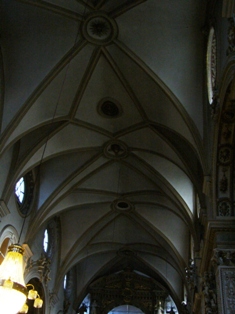
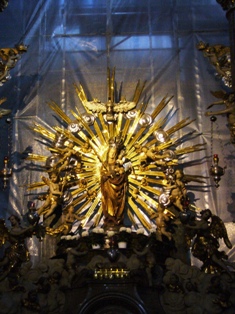
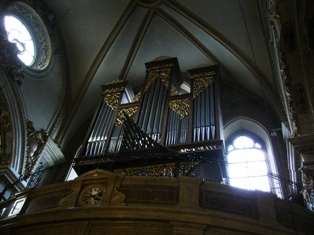


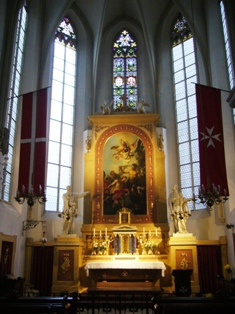
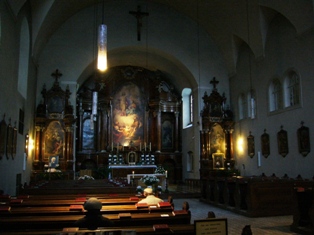

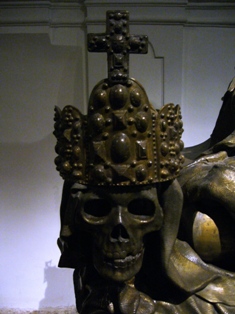
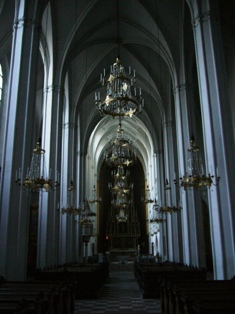
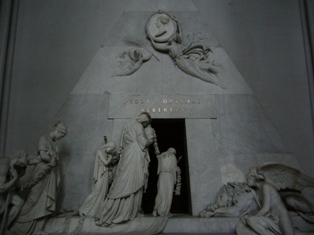


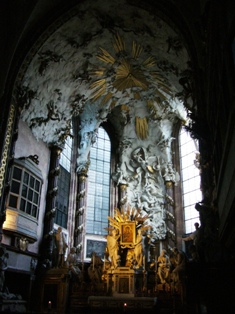
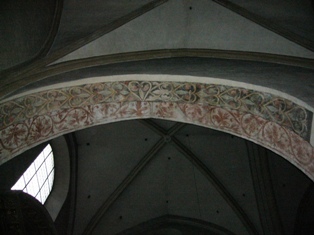





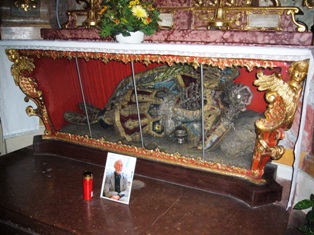


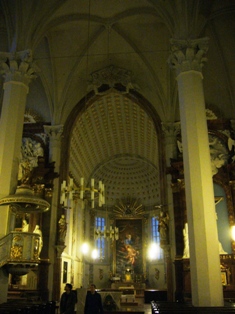
2 thoughts on “Vienna: churches and horses”
Beautiful pictures! I really enjoy visiting those grand ol’ churches. They really do have a strong feeling of spirituality to them.
-Kev
Paul, fantastic summary. Now I know I must get back there as part of a vacation and visit all of these fantastic places. Thanks again for taking the time to put this together.